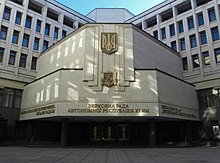The politics of Ukraine take place in a framework of a semi-presidential republic and a multi-party system. A Cabinet of Ministers exercises executive power. Legislative power is vested in Ukraine's parliament, the Verkhovna Rada.

Anti-NATO protests took place in the Ukrainian port city of Feodosia from late May to early June 2006, partially disrupting a joint Ukrainian-U.S. military exercise, which was canceled 20 July 2006.
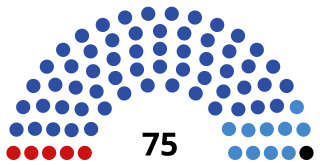
The State Council of Crimea is the parliament of the Russia-administered Republic of Crimea. It claims to be a continuation of the 'Supreme Council of Crimea' following a vote by the Ukrainian parliament to dissolve the Supreme Council of Crimea. The Parliament is housed in the Parliament building in the centre of Simferopol.
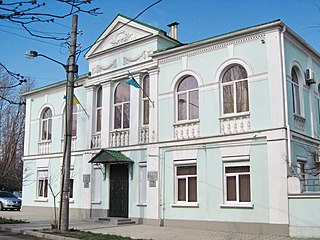
The Mejlis of the Crimean Tatar People is the single highest executive-representative body of the Crimean Tatars in period between sessions of the Qurultay of the Crimean Tatar People. The Mejlis is a member institution of the Platform of European Memory and Conscience.
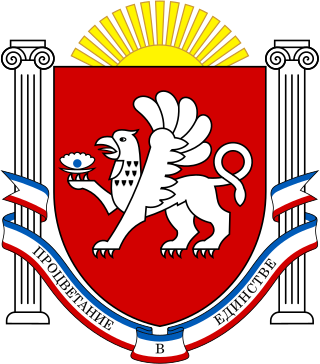
The chairman of the Council of Ministers of the Republic of Crimea, is the head of government of the Republic of Crimea.
The politics of Crimea today is that of the Republic of Crimea on one hand, and that of the federal city of Sevastopol on the other, within the context of the largely unrecognised annexation of Crimea by the Russian Federation in March 2014.

The Party "Soyuz" is a pro-Russian political party in Ukraine that was mostly based in Crimea until 2014. It was registered in June 1997 under a registration number 867.

The Constitution of the Autonomous Republic of Crimea is the basic law of the Autonomous Republic of Crimea, a republic on the Crimean peninsula as part of Ukraine. The constitution establishes the republic's status and authority within Ukraine. It granted Crimea the right to draft a budget and manage its own property.

The Council of Ministers of the Autonomous Republic of Crimea, briefly SovMin, is the executive branch of government of the Autonomous Republic of Crimea, a republic within southern Ukraine that is currently suspended due to Russian occupation of the Crimean Peninsula since February 27, 2014. The Council of Ministers derived its authority from the Constitution and laws of Ukraine and normative acts of the Verkhovna Rada of Crimea which bring them into its competency.
"For Yanukovych!" was a political alliance in Crimea between the Party of Regions and the Russian Bloc during the 2006 Crimean parliamentary election.

Vladimir Andreyevich Konstantinov is a Crimean and Russian politician who has served as the Chairman of the State Council of the Republic of Crimea since 17 March 2014.

The Autonomous Republic of Crimea is an administrative division of Ukraine encompassing most of Crimea that was unilaterally annexed by Russia in 2014. The Autonomous Republic of Crimea occupies most of the peninsula, while the City of Sevastopol occupies the rest.

In February and March 2014, Russia invaded the Crimean Peninsula, part of Ukraine, and then annexed it. This took place in the relative power vacuum immediately following the Revolution of Dignity. It marked the beginning of the Russo-Ukrainian War.

The Republic of Crimea is a republic of Russia, comprising most of the Crimean Peninsula, but excluding Sevastopol. Its territory corresponds to the pre-2023 territory of the Autonomous Republic of Crimea, a de jure subdivision of Ukraine. Russia occupied and annexed the peninsula in 2014, although the annexation remains internationally unrecognized.

On 27 February 2014, the Crimean Verkhovna Rada of Ukraine was taken over by unmarked Russian soldiers. It was among the events that triggered the Russo-Ukrainian War and laid the foundation for Crimea's annexation three weeks later. The Prosecutor's Office of Ukraine's Autonomous Republic of Crimea described the incident as a terrorist attack. A few hours into the takeover, Russia replaced the Prime Minister of Crimea, removing Ukrainian politician Anatolii Mohyliov and installing Russian politician Sergey Aksyonov in his stead.

The Republic of Crimea was the interim name of a polity on the Crimean peninsula between the dissolution of the Crimean Autonomous Soviet Socialist Republic in 1992 and the abolition of the Crimean Constitution by the Ukrainian Parliament in 1995. This period was one of conflict with the Ukrainian government over the levels of autonomy that Crimea enjoyed in relation to Ukraine and links between the ethnically Russian Crimea and the Russian Federation.

With the dissolution of the Soviet Union and Ukrainian independence the majority ethnic Russian Crimean peninsula was reorganized as the Republic of Crimea, after a 1991 referendum with the Crimean authorities pushing for more independence from Ukraine and closer links with Russia. In 1995 the Republic was forcibly abolished by Ukraine with the Autonomous Republic of Crimea established firmly under Ukrainian authority. There were also intermittent tensions with Russia over the Soviet Fleet, although a 1997 treaty partitioned the Soviet Black Sea Fleet allowing Russia to continue basing its fleet in Sevastopol with the lease extended in 2010. Following the impeachment of the relatively pro-Russia Ukrainian President Viktor Yanukovych, Russia invaded Crimea, overthrew the elected Autonomous government and claimed to annex it in 2014.
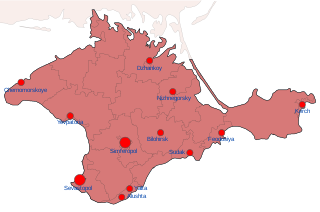
On 27 February 2014, unmarked Russian soldiers were deployed to the Crimean Peninsula in order to wrest control of it from Ukraine, triggering the Russo-Ukrainian War. This military occupation, which the Ukrainian government considers to have begun on 20 February, laid the foundation for the Russian annexation of Crimea on 18 March 2014. Under Russia, the Ukrainian Autonomous Republic of Crimea was replaced by the Republic of Crimea, though the legitimacy of the latter is scarcely recognized internationally.

Squatting in Crimea, also called the Samozakhvat is the ongoing process of illegal occupation of land in Crimea. In the Ukrainian media, squatting is primarily discussed in regards to Crimean Tatar returnees, though most squatters are Slavs. The process, which began in the late 1980s following exiled Crimean Tatars being granted the right to return to the Crimean peninsula, has been caused by the inability of the Ukrainian and Russian governments to efficiently give land grants to Crimean Tatars. As a result of the slow process, many Crimean Tatars have turned to erecting impromptu structures on undeveloped land.
Anatoliy Pavlolyvch Hrytsenko is a Ukrainian politician who had last served as the 11th Governor of Kherson Oblast in 2010.

